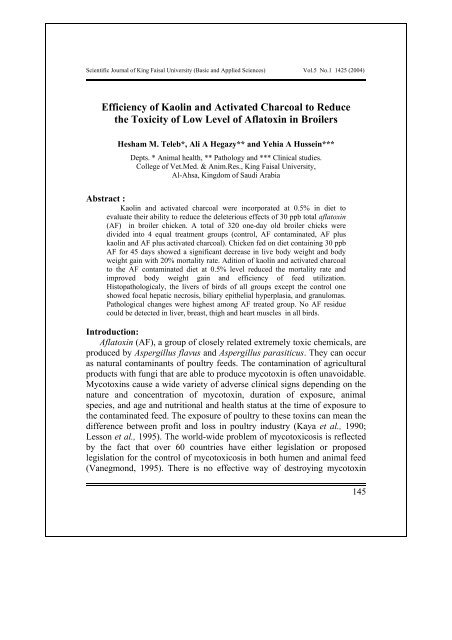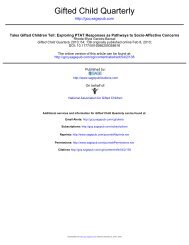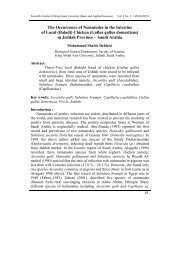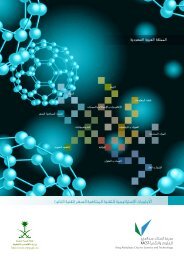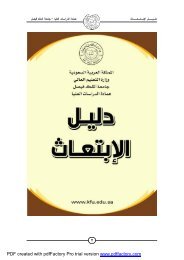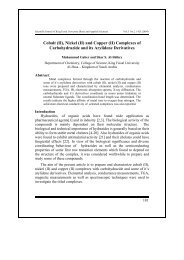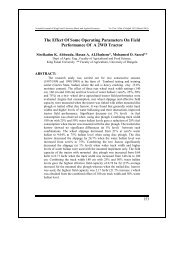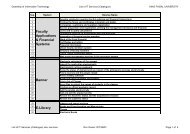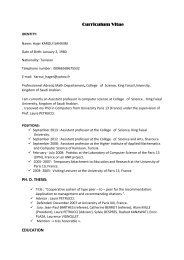Efficiency of Kaolin and Activated Charcoal to Reduce the Toxicity of ...
Efficiency of Kaolin and Activated Charcoal to Reduce the Toxicity of ...
Efficiency of Kaolin and Activated Charcoal to Reduce the Toxicity of ...
You also want an ePaper? Increase the reach of your titles
YUMPU automatically turns print PDFs into web optimized ePapers that Google loves.
Scientific Journal <strong>of</strong> King Faisal University (Basic <strong>and</strong> Applied Sciences) Vol.5 No.1 1425 (2004)<strong>Efficiency</strong> <strong>of</strong> <strong>Kaolin</strong> <strong>and</strong> <strong>Activated</strong> <strong>Charcoal</strong> <strong>to</strong> <strong>Reduce</strong><strong>the</strong> <strong>Toxicity</strong> <strong>of</strong> Low Level <strong>of</strong> Afla<strong>to</strong>xin in BroilersHesham M. Teleb*, Ali A Hegazy** <strong>and</strong> Yehia A Hussein***Depts. * Animal health, ** Pathology <strong>and</strong> *** Clinical studies.College <strong>of</strong> Vet.Med. & Anim.Res., King Faisal University,Al-Ahsa, Kingdom <strong>of</strong> Saudi ArabiaAbstract :<strong>Kaolin</strong> <strong>and</strong> activated charcoal were incorporated at 0.5% in diet <strong>to</strong>evaluate <strong>the</strong>ir ability <strong>to</strong> reduce <strong>the</strong> deleterious effects <strong>of</strong> 30 ppb <strong>to</strong>tal afla<strong>to</strong>xin(AF) in broiler chicken. A <strong>to</strong>tal <strong>of</strong> 320 one-day old broiler chicks weredivided in<strong>to</strong> 4 equal treatment groups (control, AF contaminated, AF pluskaolin <strong>and</strong> AF plus activated charcoal). Chicken fed on diet containing 30 ppbAF for 45 days showed a significant decrease in live body weight <strong>and</strong> bodyweight gain with 20% mortality rate. Adition <strong>of</strong> kaolin <strong>and</strong> activated charcoal<strong>to</strong> <strong>the</strong> AF contaminated diet at 0.5% level reduced <strong>the</strong> mortality rate <strong>and</strong>improved body weight gain <strong>and</strong> efficiency <strong>of</strong> feed utilization.His<strong>to</strong>pathologicaly, <strong>the</strong> livers <strong>of</strong> birds <strong>of</strong> all groups except <strong>the</strong> control oneshowed focal hepatic necrosis, biliary epi<strong>the</strong>lial hyperplasia, <strong>and</strong> granulomas.Pathological changes were highest among AF treated group. No AF residuecould be detected in liver, breast, thigh <strong>and</strong> heart muscles in all birds.Introduction:Afla<strong>to</strong>xin (AF), a group <strong>of</strong> closely related extremely <strong>to</strong>xic chemicals, areproduced by Aspergillus flavus <strong>and</strong> Aspergillus parasiticus. They can occuras natural contaminants <strong>of</strong> poultry feeds. The contamination <strong>of</strong> agriculturalproducts with fungi that are able <strong>to</strong> produce myco<strong>to</strong>xin is <strong>of</strong>ten unavoidable.Myco<strong>to</strong>xins cause a wide variety <strong>of</strong> adverse clinical signs depending on <strong>the</strong>nature <strong>and</strong> concentration <strong>of</strong> myco<strong>to</strong>xin, duration <strong>of</strong> exposure, animalspecies, <strong>and</strong> age <strong>and</strong> nutritional <strong>and</strong> health status at <strong>the</strong> time <strong>of</strong> exposure <strong>to</strong><strong>the</strong> contaminated feed. The exposure <strong>of</strong> poultry <strong>to</strong> <strong>the</strong>se <strong>to</strong>xins can mean <strong>the</strong>difference between pr<strong>of</strong>it <strong>and</strong> loss in poultry industry (Kaya et al., 1990;Lesson et al., 1995). The world-wide problem <strong>of</strong> myco<strong>to</strong>xicosis is reflectedby <strong>the</strong> fact that over 60 countries have ei<strong>the</strong>r legislation or proposedlegislation for <strong>the</strong> control <strong>of</strong> myco<strong>to</strong>xicosis in both humen <strong>and</strong> animal feed(Vanegmond, 1995). There is no effective way <strong>of</strong> destroying myco<strong>to</strong>xin145
<strong>Efficiency</strong> <strong>of</strong> kaolin <strong>and</strong> activated charcoal…Hesham M. Teleb et. al.once is formed. Practical <strong>and</strong> effective methods <strong>to</strong> de<strong>to</strong>xify AF containingfeedstuffs are in great dem<strong>and</strong>. A variety <strong>of</strong> physical, chemical <strong>and</strong>biological approches have beenrted (Goldblatt <strong>and</strong> Dollear, 1979; Andrson,1983; Smith, 1984; Philips et al., 1988; Gazia et al., 1991; Park, 1993 <strong>and</strong>Santurio et al., 1999). Ano<strong>the</strong>r approach <strong>to</strong> <strong>the</strong> problem has been <strong>to</strong> use nonnutritive<strong>and</strong> inert adsorbents in <strong>the</strong> diet <strong>to</strong> bind AF <strong>and</strong> reduce <strong>the</strong>irabsorption from gastrointestinal tract. These compounds must not beabsorbed from gastrointestinal tract <strong>and</strong> must have <strong>the</strong> ability <strong>to</strong> bindphysically with <strong>the</strong> chemical substances <strong>and</strong> precludes <strong>the</strong>ir absorption. Themajor advantages <strong>of</strong> <strong>the</strong>se adsorbents include expense, safety, <strong>and</strong> easyadministration through addition <strong>to</strong> <strong>the</strong> animal feed (Ledoux et al., 1999).Zeolites (hydrated sodium calcium aluminosilicat (Kubena et al., 1993 &1998; Kececi et al., 1998; <strong>and</strong> Ledoux et al., 1999), activated charcoal(Dalvi <strong>and</strong> Ademoyero, 1984; Dalvi <strong>and</strong> McGowan, 1984; Kubena et al.,1993 & 1998) <strong>and</strong> clinoptilolite (Oguz et al., 2000) have been used for thispurpose. Food <strong>and</strong> Drugs Administration (FAD) <strong>of</strong> <strong>the</strong> United States <strong>of</strong>America estimated 20 ppb as tentative maximal allowance <strong>to</strong>lerance <strong>of</strong> AFin broiler feed. The objectives <strong>of</strong> this study were <strong>to</strong> evaluate <strong>the</strong> efficiency<strong>of</strong> two binding agents (kaolin <strong>and</strong> activated charcoal) for protection againstlow-level Afla<strong>to</strong>xicosis, in broiler chicken. Growth performance,his<strong>to</strong>pathological change, <strong>and</strong> AF residue in <strong>the</strong> edible meat were utilized asevalua<strong>to</strong>ry parameters.Materials <strong>and</strong> MethodsChicken <strong>and</strong> dietsThree hundred <strong>and</strong> twenty <strong>of</strong> one-day old broiler chicks (Hubbard) <strong>of</strong>both sex obtained from a commercial hatchary were used in this study.Ckicks were individually weighed <strong>and</strong> divided r<strong>and</strong>omlly in<strong>to</strong> four equaldesignated groups 1, 2, 3 <strong>and</strong> 4. Chicks were allowed access <strong>to</strong> feed <strong>and</strong>water ad libitum . Basal diet was formulated according <strong>to</strong> <strong>the</strong> NationalResearch Council (NRC, 1994) requirement. The basal diet was tested forpossible residual AF before feeding (Samuel, 1978). The experiment lasted45 days.Afla<strong>to</strong>xin preparation:Aspergillus flavus was grown on corn meal as described by Harvey et al.(1989),<strong>and</strong> Kubena et al. (1990 & 1993) . The contaminated AF corn was146
Scientific Journal <strong>of</strong> King Faisal University (Basic <strong>and</strong> Applied Sciences) Vol.5 No.1 1425 (2004)analyized for AF content using Thin Layer Chroma<strong>to</strong>graphy (TLC) Samuel(1978). The contaminated corn was incorporated in<strong>to</strong> diets every three days<strong>to</strong> achieve <strong>the</strong> desirable concentration <strong>of</strong> 30 µ g <strong>to</strong>tal AF/ kg <strong>of</strong> feed.Experimental design:The experimental chicks were allocated in<strong>to</strong> four groups <strong>of</strong> 80 chickseach. Each group was fed as follows: group 1, control basal diet; group 2,basal diet plus 30 µ g AF /kg; group 3, basal diet plus 30 µ g AF / kg plus0.5% kaolin; group 4, basal diet plus 30 µ g AF / kg plus 0.5% activatedcharcoal (Table 1).Birds were observed daily for mortality <strong>and</strong> adverse clinical signsthroughout <strong>the</strong> experimental period. Feed consumption <strong>and</strong> body- weightwere determined weekly. On days, 20, 30, <strong>and</strong> 45 (end <strong>of</strong> experiment) 5chicken <strong>of</strong> each group were weighed <strong>and</strong> slaughtered. A detailed necropsywas performance. The liver, spleen, bursa <strong>of</strong> fabricous <strong>and</strong> thymus wereweighed. Specimens <strong>of</strong> <strong>the</strong>se organs were collected in 10% neutral bufferformalin <strong>and</strong> processed for his<strong>to</strong>pathology by st<strong>and</strong>ard paraffin method.Tissue sections <strong>of</strong> 3.5 µm thickness were cut <strong>and</strong> stained with haema<strong>to</strong>xylin<strong>and</strong> eosin. Samples <strong>of</strong> breast <strong>and</strong> thigh muscles, heart, <strong>and</strong> liver wereanalysed for AF residue using TLC technique according <strong>to</strong> <strong>the</strong> method <strong>of</strong>Stzelecki (1978).Statistical analysis:The data for live body- weight, body- weight gain, feed gain <strong>and</strong> relativeweight <strong>of</strong> internal organs were expressed as mean + pooled st<strong>and</strong>ard error <strong>of</strong>means. Statements <strong>of</strong> statistical significane were based on P⊆ 0.05, usinganalysis <strong>of</strong> variance.Results:There was a significant (P ⊆ 0.05) reduction in body -weight gain (7%)in chicken fed diet contaminated with 30 ppb AF compared <strong>to</strong> <strong>the</strong> controlgroup. The decrease in body weight gain caused by AF was diminished byaddition <strong>of</strong> 0.5 % <strong>of</strong> ei<strong>the</strong>r kaolin or activated charcoal (Table, 1). Bodyweight gain was not significantly influenced when both kaolin <strong>and</strong> activatedcharcoal were added <strong>to</strong> <strong>the</strong> diet contaminated with AF compared withcontrol basal diet group. The efficiency <strong>of</strong> feed utilization (kg feed / kg body147
<strong>Efficiency</strong> <strong>of</strong> kaolin <strong>and</strong> activated charcoal…Hesham M. Teleb et. al.148
Scientific Journal <strong>of</strong> King Faisal University (Basic <strong>and</strong> Applied Sciences) Vol.5 No.1 1425 (2004)weight gain) was lower (P ⊆ 0.05) in group 2 chicks fed AF contaminateddiet than <strong>the</strong> control group. Both groups 2 <strong>and</strong> 3 chicks fed AFcontaminated diet plus ei<strong>the</strong>r kaolin or activated charcoal showed similarvalues. Regarding mortality rate, chicken fed AF contaminated diet had <strong>the</strong>highest mortality rate <strong>of</strong> 20% followed by chicken fed AF contaminated diet<strong>and</strong> treated by kaolin or activated charcoal (Table, 1). No relevantmacroscopic post mortem changes were observed at necropsy.Data presented in Table (2), show <strong>the</strong> effect <strong>of</strong> dietary treatments onrelative weight <strong>of</strong> liver, heart, spleen <strong>and</strong> bursa <strong>of</strong> fabricous. Feeding a dietcontaminated by 30 ppb AF resulted in a significanct increase in relativeweight <strong>of</strong> liver at 20 days <strong>of</strong> age compared <strong>to</strong> o<strong>the</strong>r dietary treatments. Therewas non-significant increase in liver weight throughout <strong>the</strong> rest <strong>of</strong> <strong>the</strong>experimental period. A significant increase was recorded in weight <strong>of</strong> bursa<strong>of</strong> fabricous at 35 days <strong>of</strong> age, in group 3 chicks fed AF contaminated dietplus kaolin. No significant difference was observed in relative weight <strong>of</strong>heart or spleen in all groups throughout <strong>the</strong> experimental period.No AF residues were detected in specimens <strong>of</strong> breast <strong>and</strong> thigh muscles,heart, <strong>and</strong> spleen from birds slaughtered at 20, 35 <strong>and</strong> 45 days <strong>of</strong> age.It is clear that <strong>the</strong> type <strong>of</strong> <strong>the</strong> lesions were similar in all groups, where as<strong>the</strong> incidence <strong>and</strong> severity <strong>of</strong> lesions were comparatively less common ingroups treated with kaolin or activated charcoal. The liver <strong>of</strong> all chickenconsuming diet contaminated by 30 ppb AF showed diffused areas <strong>of</strong>hepatic vacuolar degeneration. The hepa<strong>to</strong>cytes appeared swollen,vaculated with pycknotic nuclei. Bile duct proliferation occussionalyassociated with fibrosis, granuloma <strong>and</strong> periportal aggregation <strong>of</strong>mononuclear cells <strong>and</strong> hetrophils <strong>and</strong> kupffer cell proliferation wasobserved in <strong>the</strong> liver (Fig.1). Hyperplasia <strong>of</strong> epi<strong>the</strong>lial lining <strong>of</strong> gall bladderwas detected in two cases. Lymphoid depletion <strong>of</strong> bursa <strong>of</strong> fabricous wasalso seen. In group 3, chicks fed diet containing 30 ppb AF <strong>and</strong> 0.5% kaolin,<strong>the</strong>re were focal areas <strong>of</strong> hydropic degeneration (Fig. 2). Fatty infiltrationwas detected in two birds. Hyperplasia <strong>of</strong> bile ducts, granulomas, focal areas<strong>of</strong> portal <strong>and</strong> parenchymal aggregation <strong>of</strong> mononuclear cells (Fig. 3) <strong>and</strong>hetrophils in association with hepatic necrosis (Fig. 4) <strong>and</strong> kupffer cellhyperplasia were observed in individual cases at 35 <strong>and</strong> 45 days <strong>of</strong> age. Thehepatic lesions <strong>of</strong> chick fed diet containing 30 ppb AF <strong>and</strong> 0.5% activated149
<strong>Efficiency</strong> <strong>of</strong> kaolin <strong>and</strong> activated charcoal…Hesham M. Teleb et. al.150
Scientific Journal <strong>of</strong> King Faisal University (Basic <strong>and</strong> Applied Sciences) Vol.5 No.1 1425 (2004)charcoal showed fibrinous perihepatitis (2 cases) moderate <strong>to</strong> diffuse areas<strong>of</strong> hepatic vacular degeneration, hyperplasia <strong>of</strong> bile ducts occassionallyassociated with fibrosis. Portal mononuclear <strong>and</strong> hetrophilic cell aggregationwere also seen. These changes were observed after 35 days <strong>of</strong> treatement(Table 3)Table ( 3 )Effect <strong>of</strong> addition <strong>of</strong> koalin <strong>and</strong> activated charcoalon his<strong>to</strong>pathological lesionsAF Koalin Charcol35d. 45d. 35d 45d 35d 45dFibrinous Perihepatitis2Fatty changes 2Hepatic degenerationa. Focal area1 1 22b. Diffuse 31 1 3Billiary hyperplasia 3 1 2 1 2Fibrosis 2 1 1 2 1Hepatic necrosisa. Focalb. DiffuseFocal infltration withMononuclus cellsHepatic infiltration3 11313 3 13 2 2 1 2 2ParenchymalGranuloma3 1 3 1Gall blader hyperplasia 2 1Hepatic heamorrhageAnd thromb1Hepatic dissociationAnd cellular atrophy2Kupffer cellProliferation1Congestion 1Bursa lymphoidDepletion1Heart focal area <strong>of</strong> necrosis 1151
<strong>Efficiency</strong> <strong>of</strong> kaolin <strong>and</strong> activated charcoal…Hesham M. Teleb et. al.Discussion:In this study, experimental afla<strong>to</strong>xicosis was induced in broiler chickensby feeding 30 ppb AF/kg diet from one day old until 45 days old. Inin<strong>to</strong>xicated broilers a significant decrease in body weight gain <strong>and</strong>efficiency <strong>of</strong> feed utilization as well as high mortality was observed. Theseresults are in agreement with those <strong>of</strong> Bailey et al. (1998) <strong>and</strong> Kubena et al.(1998). The adverse effect <strong>of</strong> AF can be shown <strong>to</strong> inhibition <strong>of</strong> metabolizingcapacity (Dalvi <strong>and</strong> Ademoyero, 1984), protein <strong>and</strong> nucleic acid syn<strong>the</strong>sis(Smith <strong>and</strong> Hamil<strong>to</strong>n, 1970) <strong>and</strong> suppress mi<strong>to</strong>sis <strong>and</strong> DNA syn<strong>the</strong>sis(Lega<strong>to</strong>r, 1966). These may explain <strong>the</strong> nucliobiotic changes, which wereseen in <strong>the</strong> livers <strong>of</strong> AF, treated birds.The present study shows that addition <strong>of</strong> ei<strong>the</strong>r kaolin or activatedcharcoal <strong>to</strong> AF contaminated diet tends <strong>to</strong> improve <strong>the</strong> body weight gain <strong>and</strong>feed utilization. Similar effects were reported by Dalvi <strong>and</strong> Ademoyero(1984) <strong>and</strong> Dalvi <strong>and</strong> McGown (1984). In contrast <strong>to</strong> <strong>the</strong>se results, Kubenaet al. (1990) reported that <strong>the</strong> addition <strong>of</strong> activated charcoal <strong>to</strong> <strong>the</strong> diet didnot appear <strong>to</strong> have protective properties againist <strong>the</strong> effect <strong>of</strong> AFB1. Thelevel <strong>of</strong> AF used in this work was very low 30 µ g/ kg compared <strong>to</strong> level <strong>of</strong>10 ppm used by Delvi <strong>and</strong> Ademoyero (1984). <strong>Activated</strong> charcoal is nonadsorbablecarrier that adsorbe <strong>to</strong> <strong>to</strong>xic molecules, <strong>the</strong>reby eliminating <strong>the</strong>irabsotrption from <strong>the</strong> intestinal tract. Kubena et al. (1990) reported thataddition <strong>of</strong> activated charcoal <strong>to</strong> AF contaminated diet increases mortalityrate in chicken compared <strong>to</strong> those fed AF contaminated diet only, soactivated charcoal may have actually exacerbated <strong>the</strong> <strong>to</strong>xic effect. This hasnot been observed in this study, as group 4 chicks fed charcoal plus AFcontaminated diet had less mortality than ei<strong>the</strong>r groups 1, 2 <strong>and</strong> 3 whichwere ei<strong>the</strong>r fed AF contaminated diet alone or with kaolin. Thehis<strong>to</strong>pathological lesions were also less severe in groups 4 <strong>and</strong> 3 than AFfed chicks (group 2).The present data shows that <strong>the</strong> relative weight <strong>of</strong> liver was significantlyincreased for chicks consuming AF than those fed AF with addition <strong>of</strong>ei<strong>the</strong>r kaolin or activated charcoal. Huff et al. (1986) <strong>and</strong> Kubena et al.(1990) reported similar effect on relative weight <strong>of</strong> liver. These increases inrelative weight <strong>of</strong> livers may be due <strong>to</strong> liver damage, as this organ isconsidered <strong>the</strong> principle target organ for afla<strong>to</strong>xicosis (Dalvi <strong>and</strong>Ademoyero,1984). The principle lesions observed in this study occurred in152
Scientific Journal <strong>of</strong> King Faisal University (Basic <strong>and</strong> Applied Sciences) Vol.5 No.1 1425 (2004)Fig. 1: Bile duct proliferation associated with fibrosis <strong>and</strong> granuloma in <strong>the</strong>liver <strong>of</strong> chicken fed 30 ppb AF for 45 days. (H&E. X200).Fig. 2: Hepatic cell vacuolation <strong>and</strong> granulomas in chicken fed 30 ppb AFcontaminated diet for 45 days. ( H & E. X 200)155
<strong>Efficiency</strong> <strong>of</strong> kaolin <strong>and</strong> activated charcoal…Hesham M. Teleb et. al.Fig. 3 : Parenchymal <strong>and</strong> mononuclear cell aggregation in liver <strong>of</strong> chickenfed 30 ppb AF contaminated diet. ( H & E. X 200)Fig. 4 : Focal area <strong>of</strong> hepatic necrosis in chicken fed 30 ppb AF for 45days. (H & E. X 100)156
Scientific Journal <strong>of</strong> King Faisal University (Basic <strong>and</strong> Applied Sciences) Vol.5 No.1 1425 (2004)References:1. Andrson, R.A. (1983): De<strong>to</strong>xification <strong>of</strong> afla<strong>to</strong>xin contaminated corn. Page 87-90 in: Afla<strong>to</strong>xin <strong>and</strong> Aspergillus flavus in corn. U. Dienex, R. Asquith, <strong>and</strong> J.Dickens, ed. Son<strong>the</strong>rn Coop. Ser., Bull, 279. Auburn University, Auburn, AL.2. Bailey, R.H., Kubena, L.F., Harvey, R.B., Buckley, S.A. <strong>and</strong> Rollinghoira,G.E. (1998): <strong>Efficiency</strong> <strong>of</strong> various inorganic sorbeuls <strong>to</strong> reduce <strong>the</strong> <strong>to</strong>xicity <strong>of</strong>afla<strong>to</strong>xin <strong>and</strong> T-2 <strong>to</strong>xin in broiler chicken. Poultry Science , 77, 1623-1630.3. Booth, A.N. (1969): Review <strong>of</strong> <strong>the</strong> biological effects <strong>of</strong> afla<strong>to</strong>xins on swine,cattle <strong>and</strong> poutry. J. Am. Oil. Chemists Soc. , 46, Abstr. 154.4. Dalvi, R.R. <strong>and</strong> Mc Gowan (1984): Experimental induction <strong>of</strong> chronicafla<strong>to</strong>xicosis in chicken by purified afla<strong>to</strong>xin B <strong>and</strong> its reversal by activatedcharcoal , phenobarbital <strong>and</strong> reduced glutathine. Poultry Sci. , 63: 485-491.5. Dalvi, R.R. <strong>and</strong> Ademoyero, A.A. (1984): Toxic effects <strong>of</strong> afla<strong>to</strong>xin B inchicken given feed contaminated with Aspergillus flavus <strong>and</strong> reduction <strong>of</strong> <strong>the</strong><strong>to</strong>xicity by activated charcoal <strong>and</strong> some chemical agents. Avian Dis. 28: 61-69.6. Donaldson, W.E.; Tung, H.T. <strong>and</strong> Hamil<strong>to</strong>n, P.B.(1972): Depression <strong>of</strong> fattyacid syn<strong>the</strong>sis in chick liver (Gallus domesticus) by afla<strong>to</strong>xin. Compendium <strong>of</strong>biochemical physiology 41 B ,843-8477. Espada,Y.; Domingo,M.; Gomez,J. <strong>and</strong> Calvo,M.A. (1992): Pathologicallesions following an experimental in<strong>to</strong>xication with afla<strong>to</strong>xin B1 in broilerchickens. Research in Vet. Sci. 53, 275-279.8. Gazia,N; Abd-Ellah,A.M. <strong>and</strong> Sayed,A.N. (1991): Chemical treatment <strong>of</strong>myco<strong>to</strong>xin contaminated ration <strong>and</strong> possibility <strong>of</strong> its safety use <strong>of</strong> chicks.Assiut Vet. Med. J. 25(4a): 61-68.9. Goldblatt, L.A. <strong>and</strong> Dollear, F.G. (1979): Modifying myco<strong>to</strong>xin contaminationin feeds- use <strong>of</strong> mold inhibi<strong>to</strong>rs, ammoniation roasting. In : Interactions <strong>of</strong>Myco<strong>to</strong>xins in AnimalProduction. Natl. Acad. Sc., Washing<strong>to</strong>n, Dc.10. Harvey,R.B., L.F. Kubena, T.D.Phillips ,W.E.Huff, <strong>and</strong> D.E.Corrier (1989):Prevention <strong>of</strong> Afla<strong>to</strong>xicosis by addition <strong>of</strong> hydrated sodium calciumaluminosilicate <strong>to</strong> <strong>the</strong> diets <strong>of</strong> growing barrows. Am.J.Vet.Res. 50: 416-420.11. Huff, W.E., Kubena, L.F., Harvey, R.B., Corrier, D. <strong>and</strong> Hollenhauer, H.H.(1986): Progression <strong>of</strong> afla<strong>to</strong>xicosis in broiler chickens. Poultry Sci. , 65:1891-1899.157
<strong>Efficiency</strong> <strong>of</strong> kaolin <strong>and</strong> activated charcoal…Hesham M. Teleb et. al.12. Kaya,S. , Yavuz, H. <strong>and</strong> Akar, F. (1990): Myco<strong>to</strong>xin residue in some oily seedmeals. A.U. Veteriner Fakultesi Dergisi., 37, 173-180.13. Kececi,T., Oguz,H., Kur<strong>to</strong>glu, V. <strong>and</strong> Demet,O. (1998): Effects <strong>of</strong>polyvinylpolypyrrolidone syn<strong>the</strong>tic zeolite <strong>and</strong> ben<strong>to</strong>nite on serum biochemical<strong>and</strong> haema<strong>to</strong>logical characters <strong>of</strong> broiler chicken during afla<strong>to</strong>xicosis. BritishPoultry Science , 39, 452-458.14. Kiram, M.M.; Demet, O.; Ortatatli, M. <strong>and</strong> Oguz, H.(1998): The preventiveeffect <strong>of</strong> polyvinylpolypyrrolidone on afla<strong>to</strong>xicosis in broilers. AvianPathology, 27, 250- 255.15. Kratzer,F.H.; B<strong>and</strong>y,D.; Wiley,M. <strong>and</strong> Booth,A.N. (1969): Afla<strong>to</strong>xin inpoultry. Proc. Soc. Expt. Biol. Med., 131, 1281.16. Kubena,L.F.; Harvey,R.B.; Huff, W.E. <strong>and</strong> Corrier, D.E. (1990): Efficacy <strong>of</strong>hydrated sodium calcium aluminosilicate <strong>to</strong> reduce <strong>the</strong> <strong>to</strong>xicity <strong>of</strong> afla<strong>to</strong>xin <strong>and</strong>T-2 <strong>to</strong>xin. Poultry Science. 69, 1078- 1086.17. Kubena,L.F.; Harvey,R.B.; Philips,T.D.; Corrier,D.E. <strong>and</strong> Huff,W.E. (1993):Diminution <strong>of</strong> afla<strong>to</strong>xicosis in growing chickens by <strong>the</strong> dietary addition <strong>of</strong>hydrated sodium calcium aluminosilicate. Poultry Science, 69, 727-735.18. Kubena,L.F.; Harvey,B.R.; Bailey,R.H.; Buckley,S.A. <strong>and</strong> Rotlinghous (1998):Effects <strong>of</strong> hydrated sodium calcium aluminosilicate (T-Bind) on myco<strong>to</strong>xicosisin young broiler chickens . Poultry Science., 77, 1502-15019. Ledoux,D.R.; Rotlinghous,G.E.; Bermudez,A.J.; <strong>and</strong> Alanso-drbolt,M. (1999):Efficacy <strong>of</strong> hydrated sodium calcium aluminosilicate <strong>to</strong> ameliorate <strong>the</strong> <strong>to</strong>xiceffect <strong>of</strong> afla<strong>to</strong>xin in broiler chicks. Poultry Science., 78, 204-210.20. Lega<strong>to</strong>r,M. (1966): Biological effects <strong>of</strong> afla<strong>to</strong>xin in cell culture. BacterialRev., 30, 471- 477.21. Lesson,S.; Diaz,G. <strong>and</strong> Sunmers,J.D. (1995): Afla<strong>to</strong>xins . In: Poultry MetabolicDisorders <strong>and</strong> myco<strong>to</strong>xins. Eds. S. Leeson;G. Diaz;J.D.Summers. Ontario,Canada University Books pp 248-279.22. National Research Council. NRC (1994): Nutrient Requirement <strong>of</strong> Poultry (threv.ed.National Academy Press. Washing<strong>to</strong>n, Dc.23. Oguz,H.;Kececi,I; Birdane,Y.O.; Onder,F. <strong>and</strong> Kur<strong>to</strong>glu,V. (2000): Effect <strong>of</strong>clinoptilolite on serum biochemical <strong>and</strong> haema<strong>to</strong>logical characters <strong>of</strong> broilerchicks during afla<strong>to</strong>xicosis . Research in Vet Science, 69: 89-93.24. Park,D.L. (1993): Perspectives <strong>of</strong> myco<strong>to</strong>xin decontamination . Procedures <strong>of</strong>Food Additives <strong>and</strong> Contaminants. 10, 49-60.158
Scientific Journal <strong>of</strong> King Faisal University (Basic <strong>and</strong> Applied Sciences) Vol.5 No.1 1425 (2004)25. Pasteiner, S. (1997): Coping with myco<strong>to</strong>xin contaminated feedstuffs. FeedInternational, 12-18.26. Philips,T.D.; Kubena,L.F.; Harvey,R.B.; Taylor,D.S. <strong>and</strong> Heidelbaugh,N.D.(1988): Hydrated sodium calcium aluminosilicate: a high affinity absorbent forafla<strong>to</strong>xin. Poultry Science. 67: 243-247.27. Ramos,A.J.; Finkgremmels, S.J. <strong>and</strong> Hern<strong>and</strong>ez,E. (1996): prevention <strong>of</strong> <strong>to</strong>xiceffect <strong>of</strong> myco<strong>to</strong>xins by means <strong>of</strong> nonnutritive absorbent compounds. J.FoodProtection 59: 631-641.28. Robb,J. (1993): Poison myco<strong>to</strong>xins. In Practice. Nov. Vol.15(6): 278-280.29. Samuel,K.C. (1978): Afla<strong>to</strong>xin levels in labora<strong>to</strong>ry animal diet components.Zbl.Vet.Med. B, 25, 173-177.30. Santurio, J.M.; Mallmann, C.A.; Rosa, A.P.; Appel, G.; Hear,A. ; Dage-Forde,S. <strong>and</strong> Bottcher, M. (1999): Effect <strong>of</strong> sodium ben<strong>to</strong>nite on <strong>the</strong> performance<strong>and</strong> blood variables <strong>of</strong> broiler chickens in<strong>to</strong>xicated with afla<strong>to</strong>xin. Britishpoultry Science 40, 115-119.31. Sims,W.M.; Kelley,D.C. <strong>and</strong> Sanford,P.E. (1970): A study <strong>of</strong> afla<strong>to</strong>xicosis inlaying hens. Poultry Sci. 49: 1082.32. Smith,J.W. <strong>and</strong> Hamil<strong>to</strong>n,P.B. (1970) : Afla<strong>to</strong>xicosis in <strong>the</strong> broiler chicken.Poultry Sci. 49: 207-215.33. Smith,T.K. (1984): Spent canola oil bleaching clays: potential for treatment <strong>of</strong>T-2 <strong>to</strong>xicosis in rats <strong>and</strong> short-term inoculation in diets for immatureswine.Can.J. Anim. Sci. 64: 725-732.34. Strzelecki,E. L. (1978): Afla<strong>to</strong>xin determination in animal tissues. Zbl. Vet.Med.B, 25, 194-201.35. Tung, H.T.; Donaldson, W.E. <strong>and</strong> Hamil<strong>to</strong>n, P.B. (1972): Altered lipidtransport during afla<strong>to</strong>xicosis. Toxicology <strong>and</strong> Applied Pharmacology 22, 97-104. Thax<strong>to</strong>n,J.P.; Tung,H.T. <strong>and</strong> Hanil<strong>to</strong>n,P.B.. (1974): Immunosuppressionin chickens by afla<strong>to</strong>xin. Poultry Sci. 53: 721-725.36. Vanegmond,H.P. (1995): Myco<strong>to</strong>xins regulations, quality , assurance <strong>and</strong>reference materials. Food Additive <strong>and</strong> Contaminants. 12: 321-330.37. Van Zytveld,W.A.; Kelley,D.C. <strong>and</strong> Dennis,S.M. (1970): Afla<strong>to</strong>xicosis: Thepresence <strong>of</strong> afla<strong>to</strong>xins or <strong>the</strong>ir metabolities in livers <strong>and</strong> skeletal muscles <strong>of</strong>chickens. Poultry Sci. 49: 1350159
<strong>Efficiency</strong> <strong>of</strong> kaolin <strong>and</strong> activated charcoal…Hesham M. Teleb et. al.كفاءة الكوالين و الفحم النشط فى تقليل سمية معدل بسيط منالأفلاتوكسين فى علائق بدارى التسمينGGG-GGא-אאאGGGאאGGאאא–אאאאאאWא١٧٥٧KK٣١٩٨٢٪٠{٥אאאאאאא א ٣٠א٣٢٠ Kאאא ٤אאא אאאKאא٣٠א٪٢٠אאאא٤٥٪٠{٥אאאאאאאKאאאאK אאאאאאאאא אאאאאK אאאאKאאא160


